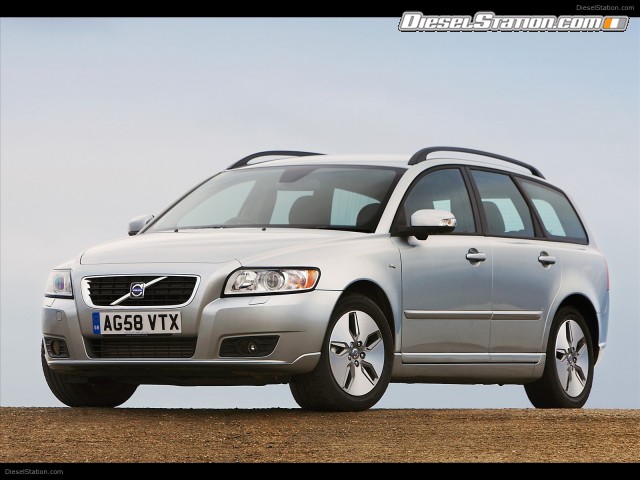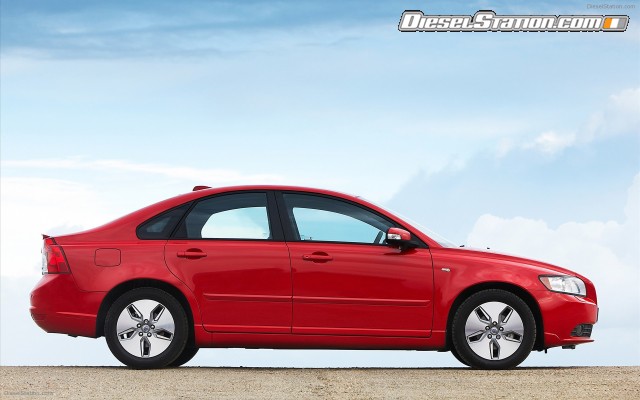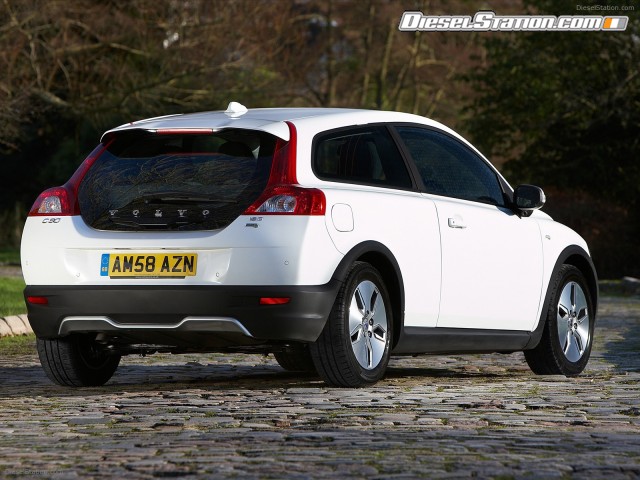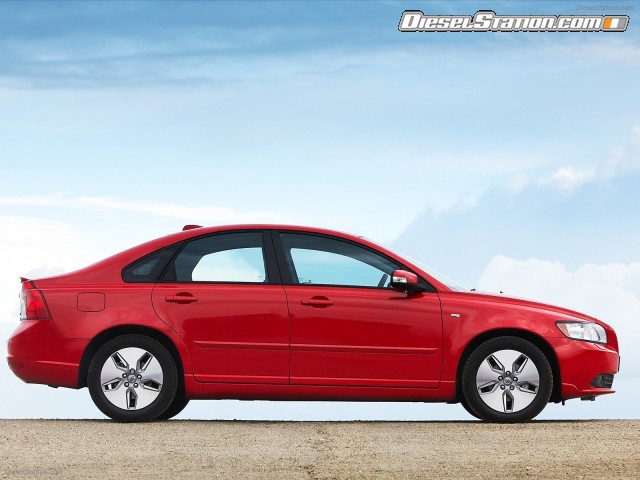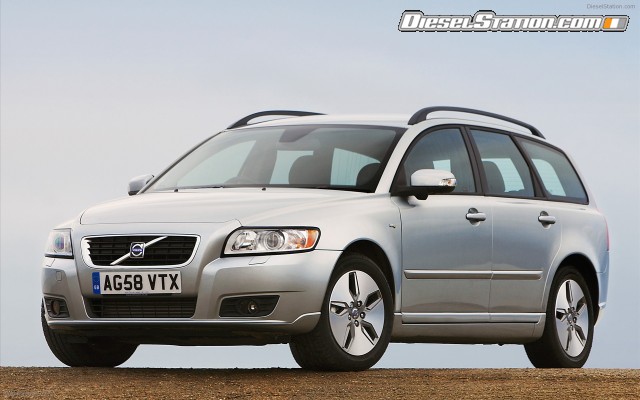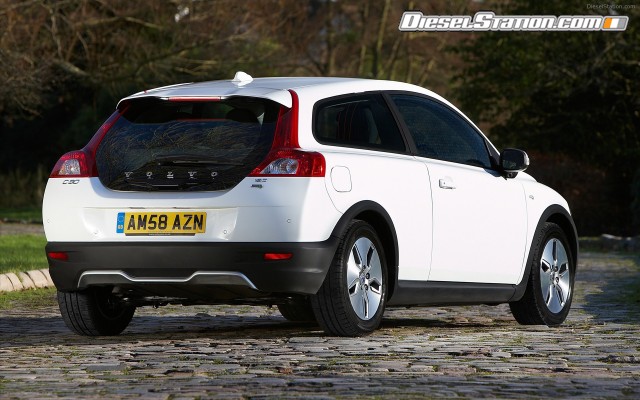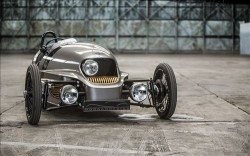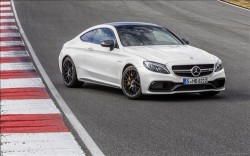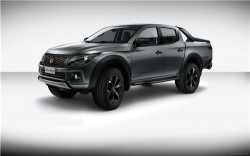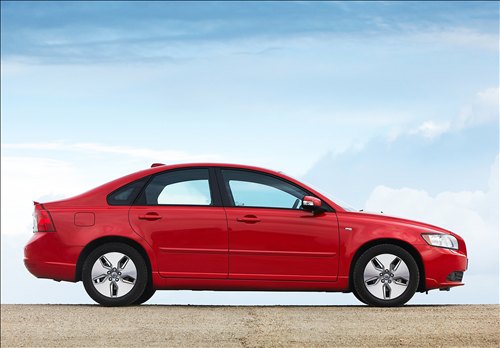Volvo is extending its green DRIVe range after dramatically reducing CO2 levels and increasing fuel efficiency in seven models. The full DRIVe range was unveiled at the Geneva Motor Show and will now include the XC60 crossover, V70 and XC70 premium estates and S80 executive saloon. The current DRIVe cars, C30 SportsCoupe, S40 saloon and V50 Sportswagon all offer class leading CO2 emissions thanks to an intelligent Start/Stop system.
All DRIVe models are equipped with a conventional diesel engine and manual gearbox optimised for extra-low fuel consumption. These cars are also tailored specifically for low rolling resistance and reduced air drag.
VOLVO DRIVe WITH START/STOP TECHNOLOGY, CLASS LEADING CO 2 EMISSIONS AND OVER 70 MPG
- Volvo is extending the DRIVe range after dramatically reducing CO 2 levels and improving fuel efficiency in seven models
- Start/Stop available on C30, S40 and V50 to offer best in class CO 2 emissions of 104 g/km in the C30 and 107 g/km for the S40 and V50
- Introducing the 1.6D engine in V70 and S80 bringing CO 2 emissions down below 130 g/km
- Front-wheel drive versions of the XC60 and XC70 with the new 2.4D engine reduces CO 2 emissions to 159 g/km, falling below the new Writing Down Allowance threshold for company cars due for introduction in April 2009
Volvo is extending its green DRIVe range after dramatically reducing CO 2 levels and increasing fuel efficiency in seven models. The full DRIVe range will be unveiled at the Geneva Motor Show on 3 March 2009 and will now include the XC60 crossover, V70 and XC70 premium estates and S80 executive saloon. The current DRIVe cars, C30 SportsCoupe, S40 saloon and V50 Sportswagon all offer class leading CO 2 emissions thanks to an intelligent Start/Stop system. All the new DRIVe models will be available in the UK in summer 2009 with further specification and pricing details being announced closer to the time.
Performance, preliminary CO 2 emissions and fuel ![]() consumption for the new Volvo DRIVe models are as follows:
consumption for the new Volvo DRIVe models are as follows:
Model |
Engine |
Power Output |
CO 2 |
Fuel Consumption |
C30 Start/Stop |
1.6D |
109 hp/240 Nm |
104 g |
72.4 mpg |
S40 Start/Stop |
1.6D |
109 hp/240 Nm |
107 g |
70.6 mpg |
V50 Start/Stop |
1.6D |
109 hp/240 Nm |
107 g |
70.6 mpg |
V70 |
1.6D |
109 hp/240 Nm |
129 g |
57.6 mpg |
S80 |
1.6D |
109 hp/240 Nm |
129 g |
57.6 mpg |
XC60 |
2.4D |
175 hp/420 Nm |
159 g |
47.1 mpg |
XC70 |
2.4D |
175 hp/420 Nm |
159 g |
47.1 mpg |
All DRIVe models are equipped with a conventional diesel engine and manual gearbox optimised for extra-low fuel consumption. These cars are also tailored specifically for low rolling resistance and reduced air drag.
C30, S40 and V50 featuring an advanced Start/Stop function to lower CO 2 emissions to 104 g/km
In order to reduce CO 2 emissions to 104 g/km for the C30 and 107 g/km for the S40 and V50, the new DRIVe versions have been equipped with two intelligent new features. The first is a Start/Stop function that allows the engine to switch off when the car is at a standstill, whilst also maintaining comfort settings such as the air conditioning.
When the driver puts the gear lever into neutral and releases the clutch while at a standstill, the engine switches off. The next time the driver presses the clutch, the engine starts up again. This technology has reduced fuel consumption and thus CO 2 emissions by 4-5% in mixed driving conditions. Start/Stop technology is particularly effective in urban traffic, when the saving can be as much as 8%.
When the car is at a standstill and the engine is switched off, some electronic systems such as the air conditioning step down to standby level in order to save fuel. However, Volvo's Start/Stop system continuously monitors the comfort level and automatically reactivates the air conditioning if, for instance, the temperature increases in the passenger compartment. The system does not set any limits for comfort-focused features such as the sound system or other facilities that the occupants will want to maintain.
This innovative monitoring system has been made possible due to an additional small battery which supports the larger battery by providing extra power. Thanks to this extra battery, Volvo's DRIVe models also feature particularly quick and smooth start-up. The audio system also remains unaffected when the starter motor is activated. This distinguishes Volvo Car's solution from other systems offered by the competition. The standard larger battery has also been upgraded to handle up to 175,000 Start/Stop cycles.
The driver continuously receives feedback about system status via the in-car information display. The Start/Stop function can be engaged and disengaged via a DRIVe button in the centre console and in the default setting, the function is activated.
The second new feature in the C30, S40 and V50 DRIVe 1.6D with Start/Stop is a regenerative charge facility. This charges the battery as soon as the driver releases the accelerator or brakes while a gear is engaged. By harnessing the car's kinetic energy, the alternator does not have to use diesel fuel as a power source to recharge the car's battery. Fuel savings of between 2 and 3% have been achieved with this function.
Introducing Front-Wheel Drive to the Volvo XC60 and XC70, bringing CO 2 emissions below 160 g/km
The introduction of front-wheel drive and the new 2.4D engine to the XC60 crossover and XC70 premium estate will see CO 2 figures tumble to 159 g/km. This will mean the XC60 will be the first premium SUV falling below the all-important 160 g/km Writing Down Allowance threshold for company cars, making the award-winning XC60 an attractive choice for the Fleet Manager once the threshold has been adopted on 1 April. Company car drivers will also benefit significantly from lower Benefit-in-Kind taxation bills.
In addition to front-wheel drive, a number of improvements all help deliver the new model's competitive fuel consumption and CO 2 figures. Volvo Cars' engine experts have also succeeded in reducing friction and pump losses in the diesel engine and in cutting the pressure drop in the intake and exhaust systems.
Injection pressure has increased with the latest generation of high-pressure pumps and the injection architecture has been refined with the help of a piezo-electric system. The engine now has lower compression, more efficient combustion and the latest generation of engine management software. What is more, the turbocharger has been tuned to deliver high torque from low revs.
The gear ratios have also been optimised so the car can be driven economically. For instance, when driving at 62 mph in top gear, engine revs and thus also fuel consumption are significantly lower with the new powertrain.
One important part of the development brief was to retain the sporty driving properties.
"More horsepower, higher torque and a sporty chassis setting all help give the front-wheel drive version of the XC60 and XC70 the right driving dynamics. It is the perfect choice for the customer who wants to focus on CO 2 emissions without compromising on driving pleasure," says Magnus Jonsson, Senior Vice President, Product Development at Volvo Cars.
V70 and S80 slip below 130 g
The Volvo V70 and S80 DRIVe models will come equipped with the same powertrain – 1.6-litre diesel engine and manual gearbox – as the smaller C30, S40 and V50 but with specially tailored engine software and different ratios in third, fourth and fifth gears.
The optimised powertrain is a major aid in helping Volvo's larger cars significantly cut their fuel consumption and CO 2 emissions to 57.6 mpg and 129 g/km respectively.
Several other factors also contribute to the reduction in fuel consumption, for example the tyres that have been specially designed for low rolling resistance. The V70 and S80 DRIVe versions are also equipped with an electric power steering pump that delivers exactly the servo assistance the driver requires, in a precise and energy-efficient way. All DRIVe models feature this power steering system. The V70 also features a covered grille to aid aerodynamics and a lowered chassis (20 mm front, 15 mm rear).
Improving the efficiency of the entire product range
Volvo Car's improvements to the environmental properties of its product range are not limited to the DRIVe versions. All the automatic transmissions will be 5-7% more efficient in forthcoming versions within the next two years.
"Our aim is to offer cars that have the lowest CO 2 emissions in each size class. DRIVe is the symbol for this process and the cars bearing this badge are those with which we have made most progress. However, the fuel-efficiency focus encompasses all our products and powertrains. By offering a broad-based product portfolio with highly economical and more powerful alternatives, the customer is able to choose his or her own level of environmental imprint," concluded Magnus Jonsson.




